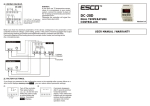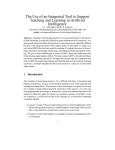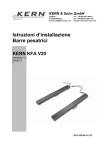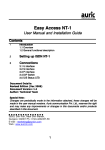Download User manual
Transcript
9. WIRING DIAGRAM. 1 3 2 4 5 T1 - temperature sensor D1 - digital input ES-10D TEMPERATURE CONTROLLER 11 12 13 14 15 16 OUT1 Make sure that the electrical parameters of the device correspond to the parameters of the controller (maximum voltage and current rating). Connection diagram of the heating device (for example boiler, heater) or cooling device (fan, circulation pump): Heating or cooling device N L ES-10 20(8)A 250VAC 11 12 13 14 15 16 L N L L 230VAC N 10. ADMISSIONS. Controller meets the requirements for immunity to electromagnetic interference in an industrial environment according to the following standards: Electromagnetic compatibility (EMC): –EN-61000 part 6-4 – requirements for emissivity in an industrial environment –EN-61000 part 6-2 – requirements for immunity in an industrial environment It also meets the safety requirements according to standard: –EN-61000 part 1 – safety requirements for eletrical devices Controller meets the requirements of EU directives No. 72/23/EEC; 93/68/EEC; 89/336EEC. USER MANUAL / WARRANTY Version 3.0 5.4. DEFROSTING (for cooling applications). 1. SPECIFICATIONS. Input: Temperature sensor: NTC 5k by 25°C bistate input (normally opened or normally closed) Measuring range: -50...+150°C Measuring accuracy: ±0,5% Sampling period: 330 ms Display resolution: 0,1°C in whole range Defrosting cycle is performed by the stoppage of the compressor. Cycles control is performed automatically and run: - periodically, from time to time (F35=1) - according to the total compressor run time (F35=2). (The lower load of the cooling system, the less often defrosting cycles occur). The end of the defrosting cycle comes after passing F33 time. . In difficult working conditions, if there is a need of an additional evaporar defrosting, Process can be started manually pressing button for 5 sec. “Defrosting” diode blinks during the manual defrosting cycle. Setting resolution: 0,1°C in whole range 6. ALARM MESSAGES. Display: LED, 4 digits, 11mm height with graphic icons Control form: ON-OFF with hysteresis Protection class: Ip20 / II When alarm activates the indicator starts blinking and the sound signaller (beep) will be activated (when F83=1). According to the occurence controller turns on/off output and the front panel displays one of the following alarm messages: Power supply: 230V~ ±15% lub 12V=/~, max 3VA Operation conditions: -5...60°C; 0...85%RH (non-condensing) Storage conditions: -40...85°C; 0...85%RH (non-condensing) Statement 2. OBCIĄŻALNOŚĆ WYJŚĆ Occurence Bistate input activation Control output operation Output inactive Chamber sensor error: OPE - open circuit SHr - short circuit High temperature alarm Output inactive Low temperature alarm No influence No influence 7. INSTALLATION. Output: Relay: 30A 250V~ 105 cykli Maximum resistive charge (e.g. Heater): Maximum inductive charge (e.g. Engine): 20A, 4500W 8A, 1500W, 2HP(2KM) 3. FRONT PANEL. Be aware of the conditions where the controller operates. Install in a place, where there is not too high temperature and humidity and no condensation. Should be ventilated in order to remove the heat. ATTENTION! It is not allowed to work with electric cables when the device is energized. You should avoid crossing wires using short connections. We recommend securing the source of controller power supply and temperature sensor input against electrical interference 8. MOUNTING. temperature display Mounting on a DIN rail (TS35), 50 cm width (3 modules). temperature unit indicator °C M entry to the parameters menu set temperature setting button 14 51 50 (3 mod.) 32 value increasing button 45 67,2 89,5 value decreasing button pressing for more than 5 sec. forces defrosting cycle temperature setting signalling cooling output signalling. LIGHTS: output active; BLINKS: output waits for start-up (see: F21) heating output signalling. LIGHTS: output active; BLINKS: output waits for start-up (see: F21) 35 defrosting signalling. LIGHTS: automatic defrosting mode; BLINKS: manual defrosting emergency states signalling. BLINKS: alarm active 6 50 2 Protection class IP67 2000 20 6 5. GENERAL DESCRIPTION. 4. CONTROLLER HANDLING. 5.1. ADJUSTMENT. 4.1. TEMPERATURE SETTING. Controller is used to maintain T temperature with desired hysteresis T in cooling or heating devices. Actuator control is in progress by the relay output and the temperature measurement is made by the temperature sensor. The principle of operation of the temperature control when cooling and heating: Temp. COOLING Temp. M °C set HEATING Press set button for 2 seconds Diode Using: °C lights up. M or set the desired temperature. set 91°C 6°C T=1°C T=5°C T=1°C 4°C T=1°C T=90°C T=1°C Time Output M °C 89°C Time set Output 1 1 0 Time 0 Time 5.2. TEMPERATURE ALARM. You can set upper and lower alarm threshold in controller parameters (F15 and F16 parameters), after exceeding which the high or low temperature alarm turns on. Confirm the set with set Button. Diode goes off. Remarks: – press M button in any time to cancel the setting – the setting change can be limited by F13 and F14 parameters Information: To improve quick increasing or decreasing the settings values hold the constantly for at least 1 sec. or button Temp. F15= 30°C F16= -10°C 4.2. TEMPERATURE SETTING, when the SMART function is active (parameter F84=1) High temperature alarm Smart function allows for rapid temperature change with no need of pushing the SET button. It is a very useful function for users, who often change temperatures. Low temperature alarm Time Alarm Switching delay F17= 0.1min °C 1 0 Set the temperature by or pointer in any time. Diode after 2 sec., and the controller saves the new setting. goes off Time set The alarm is turned on after the delay time (F17 parameter). Recommended time setting is 15 minutes, so that the alarm does not turn on too often in case of rapid temperature jumps. The delay can be reduced to the minimum, i.e. 6 seconds (0,1min.), if the temperature does not change abruptly. The alarm is signalled by internal buzzer or commands on the display: - high temperature alarm - low temperature alarm Buzzer can be muted by pushing any button lub turned off permanently in F83 parameter. M Remarks: –press M in any time to cancel the setting –the setting change can be limited by F13 and F14 parameters Information: To improve quick increasing or decreasing settings values hold at least 1 sec. or button constantly for 5.3. DIGITAL INPUT. Controller has digital input D1 for emergency states signalling, for example system failure, pressure control or safety thermostat activation, etc. Input type (normally opened, normally closed) is programmed by F50 parameter. After input activation, the controller turns off the outputs, turns on the beeper and the display indicates AL.d1. code. Emergency state sound signalling can be maintained, until the alarm reset by using the buttons (F50=2 or 4). 5 3 4.3. PARAMETERS PROGRAMMING. set set M Enter the menu pressing M button for 5 sec., Until command displays. M Using or button choose the parameter you want to change and enter with set key. °C set M Using set key confirm the new parameter value and return to the parameter list. 4.3. DESCRIPTION OF THE PARAMETERS. set M °C set set If the access to the menu is protected, command displays. Using , and set buttons enter the password and confirm with set Remarks: - press M button to cancel the parameter setting Information: Hold or values. button for at least 1 sec. to improve quick increasing and decreasing of setting Using or button set the desired parameter value. M M Finish programming pressing M button or enter the “End” command and press the set key or wait 30 sec. without pressing any button. Others: D1 input: Cooling applcations: Output: Adjustment: Group: Code: Description: F11 Temperature setting value. Range of changes is limited by the F14 and F13 parameters. F12 Hysteresis (temperature control accuracy). F13 Maximum temperature value possible to set by the user. F14 Minimum temperature value possible to set by the user. F15 High temperature alarm. F15=OFF – alarm off F16 Low temperature alarm. F16=OFF – alarm off F17 High and low temperature switching delay.. F19 Temperature sensor calibration. This is the value of rescaling the temperature sensor in relation to actually measured temperature. F21 Main output minimal down time. It also means the delay time of switching the output on after giving power supply. Parameter protects devices, e.g. engine against too frequent switching in case of power failure. The recommended setting is 3 minutes in cooling system with compressor. F29 Control output work mode: COOLING/HEATING F31 - F37 parameters for cooling applications: F31 Interval between defrosting cycles. F33 Maximum defrosting cycle length. F34 Dripping time of the evaporator after defrosting cycle. It is also the delay time of switching the compressor on after defrosting. F35 Defrosting cycles control method. OFF - defrosting off , 1 - automatically, from time to time equals to F31, 2 - automatically, if the total time of compressor operation reaches the value equal to F31 F37 Compressor turned on during the defrosting cycle: 0 - NO, 1 - YES F50 Digital input D1: 0 - unused; 1 - alarm when short-circuit; 2 - alarm when short-circuit with maintaince of alarm signalling; 3 - alarm when opened; 4 - alarm when opened with maintance of alarm signalling F80 Password to access the configuration menu. OFF - password protection inactive. F80 = 0000 - no password F82 Display resolution: 0=0,1°C; 1=1°C F83 Sound signalling when an alarm: 0 - buzzer muted; 1 - buzzer active F84 SMART function: 0 - active; 1 - inactive You can change temperature quickly using the pointers. F98 Reserved. F99 Controller test. Disconnect output device to make the test! Otherwise the system can crash End Exit the menu. 4 Range: F14...F13 0.1...20.0 -50.0...150.0 -50.0...150.0 -50.0...150.0 -50.0...150.0 0.1...99.9 -20.0...+20.0 Default: 0.0 1.0 150.0 -50.0 OFF OFF 15 0.0 Units: °C °C °C °C °C °C Minutes °C 0.0...10.0 0.0 Minutes COOL/HEAT HEAT - 0.1...99.9 1...99 0...99 12.0 30 5 Hours Minutes Minutes OFF,1, 2 OFF - 0, 1 0 - 0...4 0 - 0000...9999 0, 1 0, 1 OFF 0 1 - 0, 1 0 - - - -











